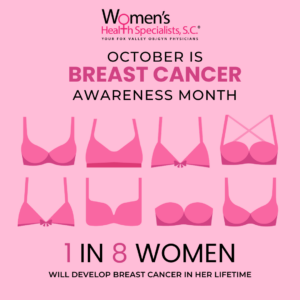 Every October I see pink EVERYWHERE! Pink shoes, scarves, hats, mittens, socks…you know what I’m saying. And then I hear women say, “Oh right, it’s Breast Cancer Awareness Month, I should get my Mammogram”. Chances are when you call to schedule, they are booking several months out. I guess it’s a good reminder to schedule a Mammogram when October comes around, but really, we should be thinking about breast cancer at least once a month when we do our self-breast exams. Self-breast exams should be done the week after a menstrual period in menstruating women and on the first day of every month in menopausal women.
Every October I see pink EVERYWHERE! Pink shoes, scarves, hats, mittens, socks…you know what I’m saying. And then I hear women say, “Oh right, it’s Breast Cancer Awareness Month, I should get my Mammogram”. Chances are when you call to schedule, they are booking several months out. I guess it’s a good reminder to schedule a Mammogram when October comes around, but really, we should be thinking about breast cancer at least once a month when we do our self-breast exams. Self-breast exams should be done the week after a menstrual period in menstruating women and on the first day of every month in menopausal women.
Breast Cancer accounts for about 30% of all new cancers in women each year in the US. About 13% (1 in 8) of US women will develop invasive breast cancer in the course of their lifetime. In 2023, an estimated 297,790 new cases of invasive breast cancer are expected to be diagnosed in US women along with 55,720 new cases of Ductal Carcinoma in Situ (DCIS)
In addition, in 2023 an estimated 2,800 new cases of invasive breast cancer are expected to be diagnosed in US men. A man’s lifetime risk is about 1 in 833.
There are currently more than 4 million women with a history of breast cancer in the US. This includes women who are currently being treated and women who have finished treatment.
Breast Cancer is still one of the leading causes of cancer-related death in US women, second only to lung cancer.
So, What Are My Risks of Getting Breast Cancer?
• Breast cancer risk increases with age
• Genetic mutations BRCA1 and BRCA2 are associated with a higher risk of breast cancer and ovarian cancer
• Periods that start before the age of 12 and menopause after the age of 55
• Being overweight
• Taking hormones
• First pregnancy after 30 or never being pregnant
• Never breastfeeding
• Drinking alcohol
• Physical inactivity
• Family history of breast or ovarian cancer
What Symptoms should I be looking for?
• A new lump in the breast or armpit area
• Thickening or swelling of part of the breast
• Irritation or dimpling of the skin of the breast
• Redness or flaky skin in the nipple area
• A pulling in of the nipple (retraction)
• Nipple discharge
• Breast pain
Any new breast symptoms should be evaluated by your healthcare provider.
I hear so many different opinions on getting a Mammogram
What’s the real story?
The American Medical Association, the American College of Obstetrics and Gynecology, the American College of Radiologists, the American Cancer Society, the National Cancer Institute and the National Comprehensive Cancer Network have all issued guidelines for Mammogram screening. The guidelines state that all women should be eligible for screening mammogram starting at age 40 and yearly thereafter.
A Mammogram is a fast procedure with minimal discomfort. Mammograms can save your life! Finding Breast Cancer early reduces your risk of dying from the disease by 30% or more.
If your breasts are dense it is best to get a digital or 3D Mammogram. This type of mammogram is recorded onto a computer, and a Radiologist can enlarge certain sections to look at them more closely
What are dense breasts and why do I have to know if I have them?
As we age, breast tissue is replaced by fatty tissue. Fatty breast tissue is easier to “see through” on Mammogram than dense breast tissue. The denser the breast tissue (not a lot of fatty tissue) the harder it is to see an abnormality.
So friends, here is the gist of this article. Wear your pink proudly, not just in October but every month of the year! Do something nice for yourself and have a Mammogram. Plan an outing with your mom or your friends – Mammogram and lunch, Mammogram and a walk, Mammogram and some shopping. They will thank you for it, I promise.